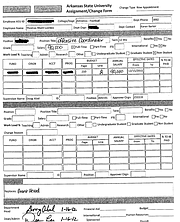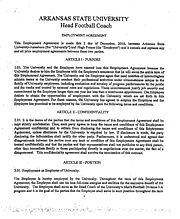LITTLE ROCK — Arkansas State heralded its hiring of Gus Malzahn in December as a big step in overhauling a modest football program into an elite midmajor one.
The school appears more than willing to pay the men tasked with job.
After ranking near the bottom of the NCAA pay scale last season, ASU’s 10 coaches are scheduled to earn at least $1.49 million in public and private pay this season, roughly doubling what the school spent in 2011 for the staff of former coach Hugh Freeze.
That amount could grow with additional compensation coming from a pool of money set aside by an ASU booster group for a staff that will be the highest-paid in the Sun Belt Conference this season.
The expenses for Malzahn, the former offensive coordinator at Auburn, and his staff represents a 72.8 percent increase from last year.
Details of the expenses came from roughly 50 pages of documents obtained by the
Arkansas Democrat-Gazette
under the Arkansas Freedom of Information Act.
“It’s a tremendous response from our fans, our support group, for them to step up and help on their side,” ASU Athletic Director Dean Lee said.
A complete picture of the staff’s pay won’t emerge until coaches file NCAA-mandated outside income forms in September. Those documents require the staff to dis- close what perks — including bonuses for working at summer football camps and monthly stipends for cars — they receive from nonuniversity sources.
But the pieces obtained from the released documents offer a glimpse of the school’s ambitions coming off its best season in 25 years, which included 10 victories, its first outright Sun Belt title and a trip to the GoDaddy.com Bowl, where the Red Wolves lost 38-20 to Northern Illinois.
The figures — particularly Malzahn’s $850,000 yearly salary — hint at the expanded role of the Red Wolf Club in its efforts to help upgrade a program that made the jump to the Football Bowl Subdivision in 1992.
“Our fans have obviously shown they’re hungry for a very competitive and successful program,” Lee said. “After the success that we achieved last year, the enthusiasm, spirit and excitement surrounding ASU is at an alltime high.”
Specific figures related to how much the Red Wolves’ coaches would earn had been scant until now, with none of the nine staff members having formal contracts in place, ASU general counsel Lucinda McDaniel said.
“The only thing we have are those hiring sheets,” Mc-Daniel said. “I’ve had several requests, and when I call over to athletics and ask, they say, ‘No.’ ”
Malzahn’s staff will earn $644,339 in state salaries this season, according to copies of hiring sheets filed in January with ASU’s department of human resources. Salary amounts range from $124,339 for defensive coordinator John Thompson, who was hired to replace Keith Patterson after he left for West Virginia, to $50,000 each for wide receivers coach Casey Woods and running backs coach Eliah Drinkwitz.
It’s unclear what incentives, such as bonuses for reaching a bowl game or winning a Sun Belt championship, each coach would receive. Those details are often included in formal contracts.
Factoring in Malzahn’s state salary of $156,210, ASU is set to pay $800,549 in public money to the staff, which itself is a 5.7 percent increase over the roughly $765,290 doled out to Freeze’s staff a year ago.
That doesn’t take into account the roughly $693,000 in salary, benefits and perks due to Malzahn from outside sources and pushes the spending level into new territory for ASU.
The spending represents a stark shift from last season, when the $866,718 paid in public and private compensation — based on contracts and income forms — for Freeze’s staff would have ranked 115th among 120 FBS programs, according to a database of coaching salaries compiled by USA Today.
What is clear is the growing role of the Red Wolf Club, a booster organization founded in 1978.
While Malzahn has a fiveyear contract with ASU, he also has a personal services agreement with the Red Wolf Club that covers an undisclosed portion of his salary, a document the booster group says it doesn’t have to provide because of its status as a federally registered nonprofit organization.
Last season, Freeze’s staff was due $101,425 in outside income, with $72,525 coming from the Red Wolf Club, according to copies of the NCAA-mandated forms filed in September 2011 with ASU’s office of the chancellor and obtained through a records request.
The bulk of the spending was a $45,000 salary supplement for Freeze — making his total salary $202,160 — and included a $1,725 country club membership in Jonesboro, his disclosure form showed. His nine assistants received $25,800 in “car stipends” from the club, which covered $300 payments for periods ranging between four months and a year.
Lee said it’s likely each of the assistant coaches would receive some pay from outside sources, but he would not reveal specific amounts set aside for each coach or offer an estimate.
It’s likely past perks — such as car stipends and country club memberships — would be included.
“That’s standard in this business across the board at Division I programs,” Lee said. “You rely on your donors and supporters to help and assist with your program in a lot of different areas. One those is obviously helping to attract, maintain and retain a top-level coaching staff.”
Rick Gillette, president of the Red Wolf Club and head of Southern Bancorp’s Trumann branch, did not return phone calls seeking comment about the amount set aside for assistant coaches, what perks the club might provide or whether there are personal service agreements in place.
But covering a sizable portion of Malzahn’s contract, along with providing perks for assistant coaches, shows donors could be sending more money to the Red Wolf Club, which raised $1.2 million in donations during fiscal 2010, according to the latest available copy of a federal form filed with the Internal Revenue Service.
Sports, Pages 19 on 05/16/2012




